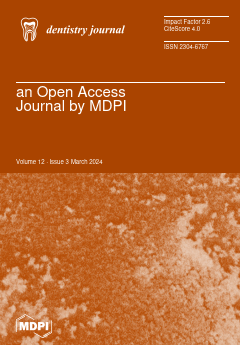The goal was to assess dental students’ perception of digital technologies after participating in a CAD/CAM exercise for scanning, designing, and manufacturing computer-aided provisional fixed dental restorations. A survey was conducted among second- (pre-D2 and post-D2), first- (D1, negative control), third-, and fourth-year
[...] Read more.
The goal was to assess dental students’ perception of digital technologies after participating in a CAD/CAM exercise for scanning, designing, and manufacturing computer-aided provisional fixed dental restorations. A survey was conducted among second- (pre-D2 and post-D2), first- (D1, negative control), third-, and fourth-year dental students (D3 and D4, positive controls). Only OSU College of Dentistry students who completed the activity and completed the surveys were included. Seven questions were rated, which evaluated changes in knowledge, skill, interest, the importance of technology availability in an office, patients’ perception of technology, the importance of having the technology, and the expected frequency of clinics utilizing the technology. Statistical analysis was performed with a significance level of 0.05. A total of 74 pre-D2 and 77 post-D2 questionnaires were completed. Additionally, 63 D1, 43 D3, and 39 D4 participants responded to the survey. Significant differences were found for “knowledge” and “skill” between the pre-D2 and post-D2 and pre-D2 and control groups (
p < 0.001). There was a significant difference between the post-D2 participants and all the controls in terms of “interest” (
p = 0.0127) and preference for in-practice technology availability (
p < 0.05). There were significant results between the post-D2 participants and all the controls regarding the importance of technology availability in an office (
p < 0.001) and the expected frequency of clinics utilizing the technology (
p = 0.01). No significance was found for “value of technology to patients” and “the importance of having the technology”. The presence of technology in practice and in educational academic environments significantly improved students’ interest and perception of their knowledge and skill.
Full article






